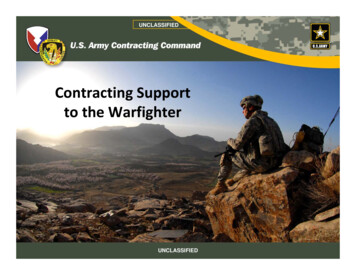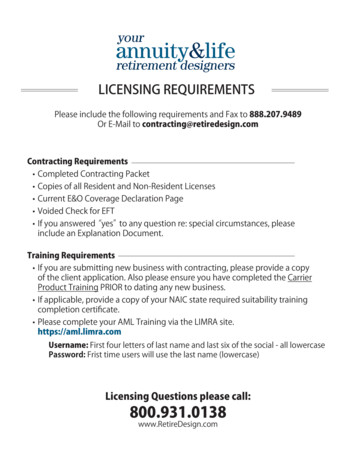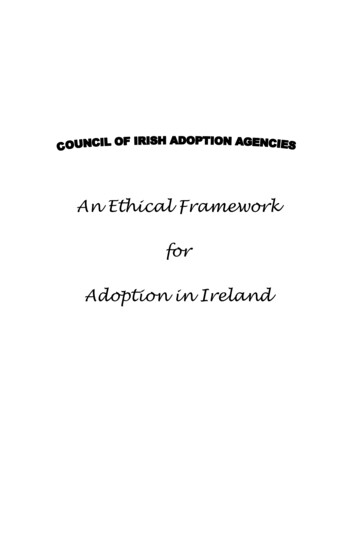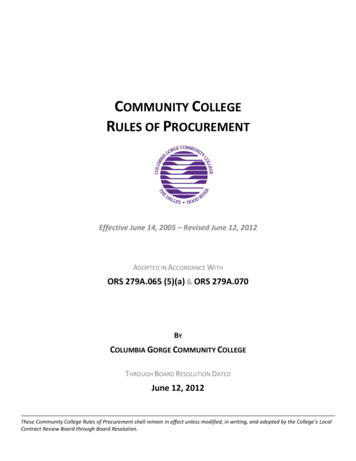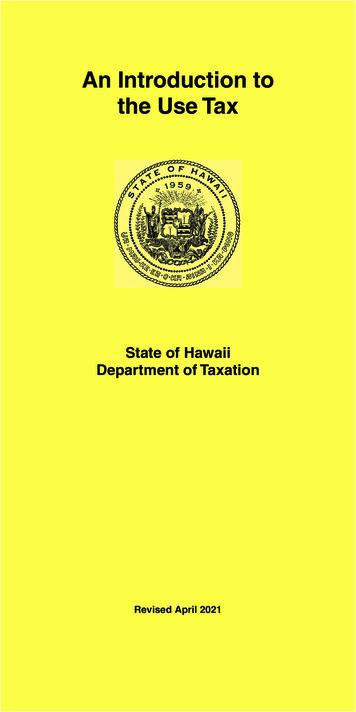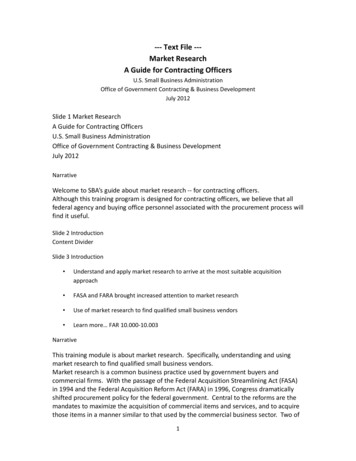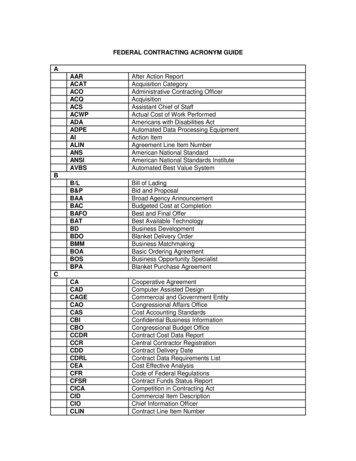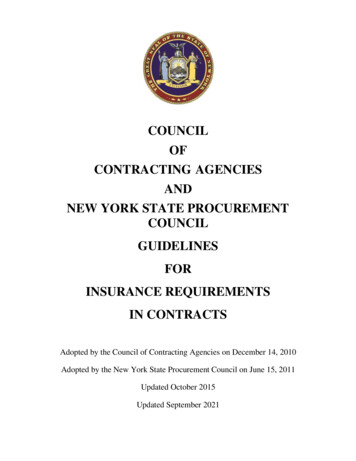
Transcription
COUNCILOFCONTRACTING AGENCIESANDNEW YORK STATE PROCUREMENTCOUNCILGUIDELINESFORINSURANCE REQUIREMENTSIN CONTRACTSAdopted by the Council of Contracting Agencies on December 14, 2010Adopted by the New York State Procurement Council on June 15, 2011Updated October 2015Updated September 2021
The Council of Contracting Agencies is comprised of the following agencies and publicauthorities:NYS Office of General ServicesNYS Department of Environmental ConservationNYS Office of Parks, Recreation and Historic PreservationNYS Department of TransportationNYS Department of LaborSUNYSUNY Construction FundNYS Division of BudgetDormitory Authority of the State of New YorkHudson River Park TrustNYS Insurance FundNYS Thruway AuthorityThe Council of Contracting Agencies (the “Council”) would like to acknowledge thecontributions made to these guidelines by Judy Tomlinson and Thomas Tyrrell, NFP, John Owens,Amsure Associates, Inc., Walter Peretti, New York State Workers’ Compensation Board, PaulHennessey, Arthur J. Gallagher & Co., and Sean Hickey, NFP. The Council extends its gratitudefor their dedication and professional guidance in the creation and updating of these guidelines.If you have questions about these guidelines or suggestions on how to improve theseguidelines, please contact the Council of Contracting Agencies’ Insurance Subcommittee atCCA.Insurance.Manual@OGS.NY.gov. If you require assistance with determining the appropriateinsurance types and/or limits for a contract, please contact your Agency’s/Authority’s InsuranceAnalyst.
TABLE OF CONTENTSI.FOREWORD . iII. MISSION STATEMENT . iIII. GLOSSARY OF INSURANCE TERMS . iiIV. INTRODUCTION . xivA. Distribution . xivB. Purpose . xivV. CHAPTERSChapter 1 – How to Use These Guidelines . 1 - 3Chapter 2 – Insurance Coverages – Descriptions and Applications . 4 - 28Chapter 3 – Model Insurance Language . 29 - 45Chapter 4 – Recommended Policy Limits . 46 - 50Chapter 5 – Contract Administration . 51 - 52
V. EXHIBITSA. Certificate of Insurance Forms –1. Exhibit A.1. – Sample ACORD Certificates of Liability Insurance(ACORD 25 (2016/03)) With Pollution and Without Pollution2. Exhibit A.2. – Sample Construction Certificate of Liability InsuranceAddendum (ACORD 855 NY) and Guidance on How to Review theForm3. Exhibit A.3 – Sample ACORD Certificate of Property Insurance(ACORD 27 (2016/03))4. Exhibit A.4 - Sample ACORD Certificate of Commercial PropertyInsurance (ACORD 28 (2016/03))5. List of Acceptable Workers’ Compensation and Disability BenefitsInsurance Forms6. Exhibit A.5-A.8. – NYS Workers’ Compensation and DisabilityBenefits Insurance Forms7. Exhibit A.9. – ELANY AffidavitB. Guidelines for Submitting Evidence of Insurance to “AGENCY”1. Exhibit B.1. – Guidelines for Submitting Evidence of Insurance2. Exhibit B.2. – Sample LetterC. “AGENCY” Procedures for Tracking and Approval and “AGENCY” InsuranceApproval Form1. Exhibit C. 1. – Procedure for Tracking and Approving Certificates ofInsurance2. Exhibit C. 2. – Insurance Approval FormD. Use of Unmanned Aircraft Systems ProcedureE.Reference Materials Information on New York State Workers’ Compensation Law Requirements: nses-contracts.pdfInsurance Services Office (ISO) Forms:1. CG 00 01 01 96Commercial General Liability Coverage Form
2. CG 20 10 11 85 Additional Insured – Owners, Lessees orContractors – (Form B)3. CG 22 79 04 13InsuranceExclusion – Contractors – Professional Liability4. CG 22 80 04 13 Limited Exclusion – Contractors ProfessionalLiability Insurance5. CG 25 03 05 09 Designated Construction Project(s) GeneralAggregate Limit6. CA 01 12 01 21 New York Changes in Business Auto and MotorCarrier Coverage Forms7. CG 00 14 04 13 Special Protective and Highway Liability PolicyNew York Department of Transportation8. CG 00 09 04 13 Owners and Contractors Protective LiabilityCoverage Form-Coverage for Operations of Designated Contractor9. CG 02 24 10 93 Earlier Notice of Cancellation Provided by US (ForUse with CGL, Liquor, Pollution and Products Policies)10. CG 20 38 12 19 Additional Insured-Owners, Lessees or ContractorsAutomatic Status for Other Parties when Required in WrittenConstruction Agreement11. CG 20 10 12 19 Additional Insured-Owners, Lessees or ContractorsScheduled Person or Organization12. CG 20 37 12 19 Additional Insured-Owners, Lessees or ContractorsCompleted Operations13. CA 20 48 10 13 Designated Insured for Covered Autos LiabilityCoverage14. CG 24 26 04 13 Amendment of Insured Contract Definition15. CP 10 30 09 17 Causes of Loss-Special Form16. CA 00 05 03 10 Garage Coverage Form17. MCS 90 Endorsement Endorsement for Motor Carrier Policies ofInsurance for Public Liability under Sections 29 and 30 of the MotorCarrier Act of 1980
I. FOREWORDThe Council was created within the New York State Executive Department by Executive OrderNumber 125 on May 22, 1989 to ensure the systematic collection and timely exchange ofinformation relevant to Agency1 determinations of the responsibility and reliability of bidders,contractors,2 and proposed subcontractors. On June 24, 2004, the Council of Contracting Agenciesestablished the Insurance Subcommittee for the purposes of establishing general Insurancestandards and practices among participating Council members.II. MISSION STATEMENTThe Council prepared these guidelines to serve as a reference tool. They are designed to advisepersonnel who prepare or negotiate contracts, leases, permits and other agreements, or who areresponsible for administering those agreements, including individuals responsible for reviewingInsurance documentation. These guidelines offer information on how to structure contractInsurance provisions, and how to monitor Contractor compliance with those requirements.The goal of these guidelines is to provide a standard for consistent Insurance-relatedlanguage and requirements for use in contract documents. While the standards referenced inthese guidelines have been developed via a collaborative effort involving participating Councilmembers and Insurance industry representatives, and the Council believes these standards bestmeet the needs of the State given the current contract and Insurance industry environments, theCouncil also recognizes that governmental entities have their own unique operations andcontracting needs. Therefore, it is understood that each Agency may find a need to deviate fromthe standards presented here as it deems necessary.The term “Agency,” as used in these guidelines shall refer to the office, board, department, commission, authority,fund, or public benefit corporation executing the contract.1The term “Contractor” as used in these guidelines shall refer to any third party entering into a contract with theAgency. As such, the term may encompass Contractors, consultants, licensees, grantees, permitees, lessees, tenantsand/or others as applicable to the Agency’s operations.2i
III. GLOSSARY OF INSURANCE TERMSThis Glossary of Insurance terms is intended as a reference for those Agency personnel whohave reason to work with Insurance industry personnel and/or documents as part of theirwork for the Agency. The terms described in the glossary are not limited to those used inother parts of these guidelines but are a compilation of terms frequently encountered indiscussions of Insurance coverage and documentation.ACCIDENT: An unexpected incident resulting in Personal Injury or property damage.ACTUAL CASH VALUE: Usually the cost of replacing or restoring property to its conditionimmediately preceding a loss, less depreciation.ADDITIONAL INSURED: A person or organization not automatically included as an Insuredunder an Insurance policy, but for whom Insured status is arranged usually by Endorsement at therequest of the policyholder. If an individual or entity is an Additional Insured on a Contractor’spolicy, it can make a Claim to the Contractor’s Insurance to pay for damages and legal fees, ratherthan relying on its own Insurance. Coverage for the Additional Insured might be limited to a singleevent or it could last for the lifetime of the policy. A Named Insured’s impetus for providingAdditional Insured status to others may be a desire to protect the other party because of a closerelationship with that party (e.g., employees or members of an Insured club) or to comply with acontractual agreement requiring the Named Insured to do so (e.g., customers or owners of propertyleased by the Named Insured).ADDITIONAL NAMED INSURED: A person or organization, other than the first NamedInsured, identified as an Insured in the policy declarations or an addendum to the policydeclarations or a person or organization added to a policy after the policy is written with the statusof Named Insured. This entity would have the same rights and responsibilities as an entity namedas an Insured in the policy declarations (other than those rights and responsibilities reserved to thefirst Named Insured). In this sense, the term can be contrasted with Additional Insured, a personor organization added to a policy as an Insured but not as a Named Insured. The term has notacquired a uniformly agreed upon meaning within the Insurance industry and use of the term inthe two different senses defined above often produces confusion in requests for Additional Insuredstatus between contracting parties. For purposes of Workers’ Compensation and DisabilityBenefits, an Additional Named Insured is a separate business entity, added to a policy that sharescommon majority ownership with the primary Insured.AGGREGATE LIMIT: A limit in an Insurance policy indicating the most that the Insurer willpay for all covered losses sustained during a specified period of time (usually a year), regardlessof the number of Claims. Aggregate Limits are generally included in liability policies.ADJUSTERS: Usually those who represent the Insurer in settling Claims with Insureds or withthird-party claimants (sometimes a representative of the Insured).ADVERTISING INJURY: A Commercial General Liability coverage, combined in standardCommercial General Liability Insurance (CGL) policies with Personal Injury coverage, thatii
insures the following offenses in connection with the Insured’s advertising of its goods or services:libel, slander, invasion of privacy, copyright infringement, and misappropriation of advertisingideas.AGENT: A person or organization who/that is authorized to act on behalf of another. AnInsurance agent is a person or organization who/that solicits, negotiates, or instigates Insurancecontracts on behalf of an Insurer and can be independent or an employee of the Insurer. Insuranceagents are the legal representatives of Insurers, rather than policyholders, with the right to performcertain acts on behalf of the Insurers they represent, such as to bind coverage.AVIATION LIABILITY INSURANCE: Insurance coverage geared specifically to theoperation of aircraft and the risks involved in aviation. Aviation Insurance policies are distinctlydifferent from those for other areas of transportation and tend to incorporate aviation terminology,as well as terminology, limits and clauses specific to Aviation Liability Insurance.BINDER: A legal agreement issued either by an Agent or a company to provide temporaryInsurance until a policy can be written. It should clearly designate the company in which the riskis bound as well as the amount, the perils insured against, and the type of Insurance.BLANKET ADDITIONAL INSURED: An Endorsement that may be attached to liabilityInsurance policies that automatically grants Insured status to a person or organization that theNamed Insured is required by contract to add as an Insured. May apply only to specific types ofcontracts or entities. Also referred to as an "automatic Additional Insured Endorsement."BOND: A three-party contract in which one party, the surety, guarantees the performance orhonesty of a second party, the principal (obligor), to the third party (obligee) to whom theperformance or debt is owed.BROKER: An Insurance intermediary who/that represents the Insured rather than the Insurer.Since they are not the legal representatives of Insurers, Brokers, unlike independent Agents, oftendo not have the right to act on behalf of Insurers, such as to bind coverage. While some brokersdo have agency contracts with some Insurers, they usually remain obligated to represent theinterests of Insureds rather than Insurers.BUILDER’S RISK INSURANCE: A Commercial Property Insurance policy that is designed tocover property in the course of construction. There is no single standard Builder’s Risk form; mostBuilder’s Risk policies are written on inland marine (rather than Commercial Property) forms.Coverage is usually written on an all risk basis, and typically applies not only to property at theconstruction site, but also to property at off-site storage locations and in transit. Builder’s RiskInsurance can be written on either a completed value or a reporting form basis; in either case, theestimated completed value of the project is used as the limit of Insurance.BUSINESS OWNER POLICY (BOP): A policy that combines protection for all major propertyand liability risks in one package. This type of policy assembles the basic coverages required bya business owner in one bundle. It is usually sold at a premium that is less than the total cost ofthe individual coverages. BOPs are usually targeted at small and medium-sized businesses. Theyiii
typically contain business interruption Insurance, which provides reimbursement for businessincome resulting from an insured loss.CAPTIVE: Captive Insurance companies are Insurance companies established with the specificobjective of financing risks emanating from their parent group or groups, but they sometimes alsoinsure risks of the group's customers as well. Using a Captive insurer is a risk managementtechnique by which a business forms its own Insurance company subsidiary to finance its retainedlosses in a formal structure. Captives cannot be created by NYS governmental entities, unlessspecifically authorized under State law.CERTIFICATE OF INSURANCE: A statement that a specified Insured and risk are covered toa specified extent, but ordinarily without responsibility on the part of the Insurer to notify thecertificate holder of termination of the Insurance.CLAIM: A demand by an individual or corporation to recover, under a policy of Insurance, forloss, which may come within that policy.CLAIMS-MADE POLICY: A policy which covers all Claims reported to an Insurer within thepolicy period irrespective of when they occurred. Contrast with Occurrence Policy.COMMERCIAL GENERAL LIABILITY INSURANCE: A standard Insurance policy issuedto business organizations to protect them against liability Claims for bodily injury (BI) andproperty damage (PD) arising out of premises, operations, products, and completed operations;and advertising and personal injury (PI) liability.COMMERCIAL PROPERTY INSURANCE: Insurance that insures against damage to theInsured’s buildings and contents due to a covered cause of loss, such as a fire. The policy mayalso cover loss of income or increase in expenses that results from the property damage.CROSS LIABILITY COVERAGE: Coverage in connection with the suit brought against anInsured by another party that has Insured status under the same policy. Cross-liability coverage isprovided as an intrinsic feature of the standard Commercial General Liability policy, by means ofthe “Separation of Insureds” clause. Some Umbrella Liability and Professional LiabilityInsurance/Errors and Omissions Liability policies contain Insured-versus-Insured exclusions thateliminate Cross-Liability Coverage.DATA BREACH AND PRIVACY INSURANCE: A form of Insurance also referred to asCYBER INSURANCE that covers consumers of technology services for various liability andproperty losses that result from an organizations engagement in a variety of electronic activitieswhich may include Internet sales or the collection of customer data. This form of Insurance coversa variety of both first- and third-party losses with varying insuring agreements available based onneed. Coverage is a separate form from a standard Commercial General Liability Insurance policywith no current standardized ISO form available.DEDUCTIBLE: A portion of covered loss that is not paid by the Insurer. Most CommercialProperty Insurance policies contain a per-Occurrence Deductible provision that stipulates that theiv
Deductible amount specified in the policy declarations will be subtracted from each covered lossin determining the amount of the Insured’s loss recovery. In Commercial Property Insurance, theDeductible is usually subtracted from the amount of the loss, whereas in liability Insurance, theDeductible usually reduces the recovery for the Claim (loss) and may or may not erode theremaining available Insurance limit. See Self-Insured retention (SIR).DISABILITY BENEFITS: A form of Insurance purchased by an employer which providesstatutory benefits required by State law to an employee when he/she is disabled by an off-the-jobrelated injury or disease.DISTRIBUTED DENIAL OF SERVICE ATTACK: A cyber-attack in which the perpetratorseeks to make a machine or network resource unavailable to its intended users by temporarily orindefinitely disrupting services of a host connected to the Internet.ENDORSEMENT: A form bearing the language necessary to record a change in an Insurancepolicy.ENVIRONMENTAL LIABILITY INSURANCE: Insurance that covers property loss andliability arising from pollution-related damages for sites that have been inspected and founduncontaminated. It is usually written on a Claims-Made basis. Generally, coverage includesstatutory clean-up requirements, bodily injury and property damage third-party Claims, and legalexpenses resulting from pollution or contamination incidents. The coverage kicks in both forincidents that are “sudden and accidental” and “gradual.” Coverage also exists for businessinterruption losses.ERRORS AND OMISSIONS LIABILITY (E & O) INSURANCE: See Professional LiabilityInsurance.EXCESS INSURANCE: A policy or Bond covering the Insured against certain hazards andapplying only to loss or damage in excess of a stated amount or specified primary or Self-Insuranceamount, including the amount in excess of that retained by an entity for its own Self-Insurance/selfretention program.EXPERIENCE RATING: A method used to determine a premium that is developed bycomparing the actual loss experience of the Insured to the loss experience that is normally expectedby others in the Insured's rating class or industry classification. This method is usually used forautomobile liability, automobile physical damage, Commercial General Liability, Workers’Compensation and unemployment policies.GARAGEKEEPERS LEGAL LIABILITY: An optional coverage designed to extend theGarage Liability Insurance policy of business owners to provide protection for vehicles while inthe Insured’s care, custody, or control. It is recommended that this coverage be written on a directv
primary basis, which provides coverage regardless of whether the Insured is legally obligated todo so.3GARAGE LIABILITY INSURANCE: Insurance covering the legal liability of automobiledealers, garages, repair shops, and service stations for Claims of bodily injury and property damagearising out of business operations. Damage to vehicles is excluded from this coverage; however,Garagekeepers’ Legal Liability coverage can be written as a part of the Garage Liability Insurancepolicy to cover that exposure.GENERAL AGGREGATE: the maximum amount of money the Insurer will pay out during aPolicy term. The General Aggregate limit places a ceiling on the Insurer’s obligation to pay forproperty damage, bodily injury, medical expenses, lawsuits, etc. which may arise during the termof the Insurance Policy.INDEMNIFICATION CLAUSE: Language inserted in contracts to protect the Agency in theevent of a loss. The actual Insurance provided by the Contractor is the mechanism by which theContractor would pay for its obligation to Indemnify the Agency for a loss arising out of workperformed in connection with the contract (or project).INDEMNIFY: To make compensation to an entity, person, or insured for incurred injury, loss,or damage.INSURANCE: A contractual relationship, which exists when one party (the Insurer), for aconsideration (the premium), agrees to reimburse another party (the Insured) for loss to a specifiedsubject (the risk) caused by designated contingencies (hazards or perils).INSURED: The person or organization protected under an Insurance contract.INSURER (ALSO KNOWN AS INSURANCE COMPANY, INSURANCE CARRIER ORUNDERWRITER): The entity which provides insurance.INSURANCE SERVICES OFFICE, INC. (ISO): The Insurance Services Office, Inc., anorganization created for the purpose of developing standard Insurance forms, collecting statisticaldata, and promulgating rates for the Insurance industry. It is a provider of statistical, actuarial,underwriting, and Claims information and analytics; compliance and fraud identification tools;policy language; information about specific locations; and technical services.JOINT VENTURE: A contractual business undertaking in which two or more parties combinetheir labor or property for a single undertaking and share profits and losses equally, or as otherwiseagreed upon in contract. Joint ventures are not normally covered by a Commercial GeneralLiability Insurance policy, unless specifically named.3Note: Consideration should be given to the fact that direct primary coverage does cost more than legal liabilitycoverage.vi
LLOYD’S OF LONDON: A marketplace for large and/or unusual Insurance exposures. Thisassociation of independent underwriters is a place where Brokers representing Insurance applicantsare able to contract with underwriters offering coverage. Lloyds does not directly underwritepolicies but acts a regulator under which its members offer Insurance policies.LONGSHORE AND HARBOR WORKERS’ COMPENSATION ACT (LHWCA): TheLongshore and Harbor Workers' Compensation Act, 33 U.S.C. § 901–950, commonly referred toas the "Longshore Act" or "LHWCA" is the statutory Workers' Compensation scheme, firstenacted in 1927, that covers certain maritime workers, including most dock workers and maritimeworkers not otherwise covered by the Jones Act. In addition, Congress extended the LHWCA tocover non-appropriated fund employees (i.e. AAFES employees), Outer Continental Shelfworkers, and U.S. government Contractors working in foreign countries. LHWCA coverage canbe obtained under a standard Workers’ Compensation policy with the purchase of an Endorsement.LOSS PAYEE: The party to whom the Claim from a loss is to be paid. A Loss Payee can meanseveral different things; in the Insurance industry, the Insured or the party entitled to payment isthe Loss Payee. A Loss Payee clause (or loss payable clause) is a clause in a contract of Insurancethat provides, in the event of payment being made under the policy in relation to the Insured risk,that payment will be made to a third-party rather than to the Insured beneficiary of the policy.Such clauses are common where the Insured property is subject to a mortgage or other securityinterest and the mortgagee, usually a bank, requires the property be Insured and that such a clausebe included. As a matter of practicality, such clauses are usually appended to the end of existingpolicies in a separate addendum after being negotiated between the Insurer and the Insuredbeneficiary.MCS-90 ENDORSEMENT: An Endorsement that must be attached to the auto liability policyof certain regulated motor carriers to assure that federally mandated coverage (e.g., requiredliability limits, environmental restitution coverage) is in place. The Endorsement does not actuallyprovide Insurance except on a reimbursement basis. For example, if the Insured motor carrier isInsured under a standard ISO, truckers or motor carrier policy without the broadened pollutionliability coverage Endorsement (CA 99 48) attached, the motor carrier may have to reimburse theInsurer in the event the Insurer has to pay a pollution liability loss.NAMED INSURED: The person, firm, or organization that enjoys the benefits of being Insuredunder the policy.NEW YORK STATE VENDOR(S): A business that has operations in and is registered in NewYork State. This could mean being incorporated, a LLC, or DBA in New York State.OCCURRENCE: An Accident, including continuous or repeated exposure to the same generalharmful conditions, which results in bodily injury or property damage neither expected norintended from the standpoint of the Insured.vii
OCCURRENCE POLICY: A policy under which all Claims occurring during the period of thepolicy are covered, irrespective of when the Claim is made. Any Claims occurring after thepolicy’s expiration date are not covered. Contrast with Claims-Made Policy.OWNER CONTROLLED INSURANCE PROGRAM (Wrap-Up Insurance Program/OCIP)4: An arrangement whereby the owner of a construction project purchases the coverage forone or more lines of Insurance for all of the parties involved in the project (except Contractorsspecifically excluded under the policy). It produces savings by consolidating the Workers’Compensation, Commercial General Liability Insurance and Builder’s Risk Insurance policies andimplementing a comprehensive safety program for all the Contractors and subcontractors in aconstruction program. Occasionally, other coverages such as Professional Liability Insurance andenvironmental impairment (except the MCS-90 Endorsement), are added to the program as well.Advantages of a Wrap-Up: Cost savings - the estimated cost savings to the owner of a well-managed“wrap-up” Insurance program are usually between 1.5% -2% of contract costs; Superior safety and loss control for workers and the general public becauseadditional safety management is brought in to the construction project; Potential for Insurers to offer broader coverage and higher limits than wouldotherwise be available; and Improved Claims handling because one Insurance administrator handles allClaims, thus reducing confusion of cross Claims and access to records.PERSONAL AND ADVERTISING INJURY: (1) A standard coverage (Coverage B) of the1986 and later CGL forms. (2) A defined term in the standard CGL since 1998, it combineselements of the earlier separate categories of “Personal Injury” and “Advertising Injury.” See alsoAdvertising Injury; Personal Injury.PERSONAL INJURY: Under Commercial General Liability Insurance coverage, a category ofinsurable offenses that produce harm other than bodily injury. As covered by the 1986 CGL policy,Personal Injury includes: false arrest, detention, or imprisonment; malicious prosecution;wrongful eviction; slander; libel; and invasion of privacy. Also addressed in the homeowners’policy. Under an Umbrella Liability policy, a broad category of insurable offenses that includesboth bodily injury and the offenses defined as “Personal Injury” in CGL policies.PRODUCTS LIABILITY: Liability arising out of manufactured goods after they leave thepremises.4Note: State contracting Agencies should be familiar with NYS laws limiting the procurement opportunitiesspecific to OCIP programs before binding such a policy.viii
PRODUCTS/COMPLETED OPERATIONS: One of the hazards ordinarily Insured by aCommercial General Liability Insurance policy. It comprises liability arising out of the Insured’sproducts or business operations conducted away from the Insured’s premises once those operationshave been completed. It typically relates to Claims arising out of a contract.PROFESSIONAL LIABILITY INSURANCE (ERRORS AND OMISSIONS LIABILITYINSURANCE): A form of liability insurance that insures against loss due to failure, through erroror unintentional omission, such as architect and engineers design error(s) in their work. Thesepolicies provide Indemnification for third-party liability Claims due to negligence in theperformance of professional services. Coverage for faulty construction work associated withprojects is normally excluded under the policies. Such insurance is commonly required fromlicensed professionals such as architects and engineers, lawyers, accountants, Insurance Brokers,financial advisors and other professional service firms, but it also may be required for non-licensedconsultants, executive recruiters, graphic designers, translators, travel agents and otherprofessionals that provide advice to an Agency.RAILROAD PROTECTIVE LIABILITY INSURANCE: Insurance coverage protecting arailroad from liability exposures due to the work of Contractors or subcontractors on or near therailroad right-of-way. This Insurance coverage is generally required by the railroad and lists therailroad as the Named Insured.RISK MANAGEMENT: The practice of identifying, analyzing, and taking steps to reduc
2. CG 20 10 11 85 Additional Insured - Owners, Lessees or Contractors - (Form B) 3. CG 22 79 04 13 Exclusion - Contractors - Professional Liability Insurance 4. CG 22 80 04 13 Limited Exclusion - Contractors Professional Liability Insurance 5. CG 25 03 05 09 Designated Construction Project(s) General Aggregate Limit 6. CA 01 12 01 21 New York Changes in Business Auto and Motor
